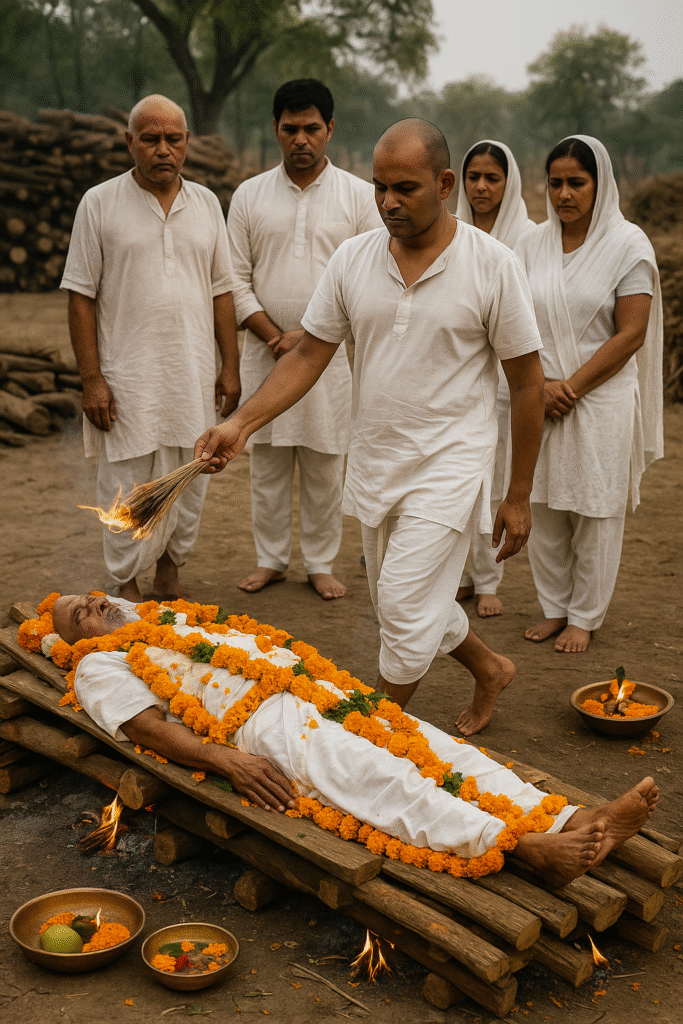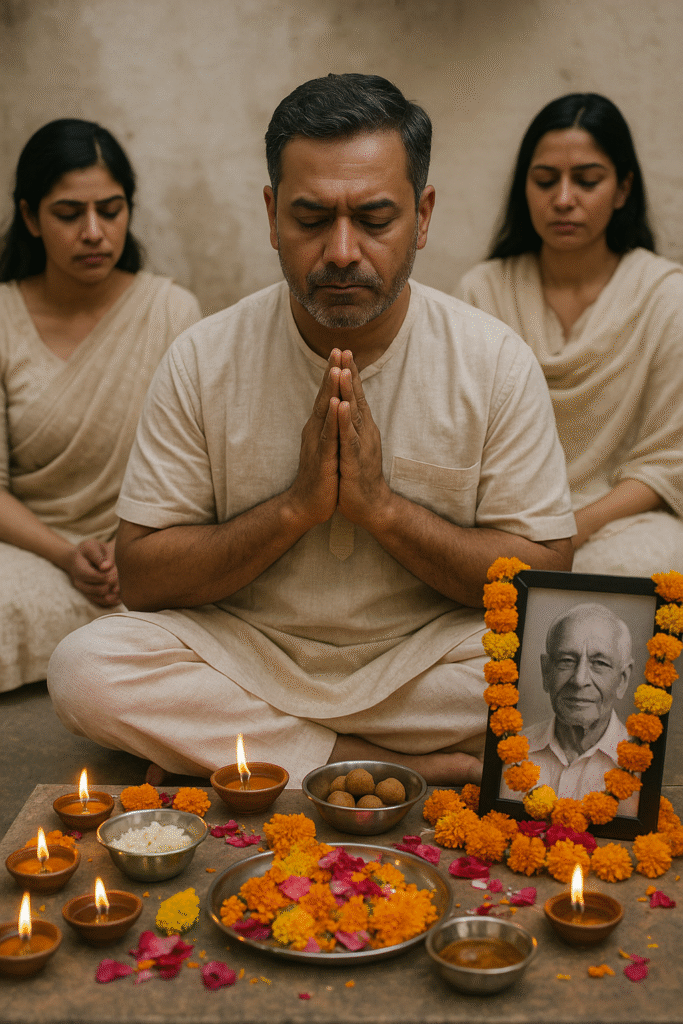Call Us 24/7:
Hindu Funeral Rituals and Cremation Practices
In Hinduism, death is seen as a sacred transition within the cycle of birth, death, and rebirth (samsara). Funeral rites aim to release the soul (atman) from its earthly attachments and guide it toward spiritual liberation (moksha), while also offering comfort and continuity to the living.
Cremation is the preferred method of disposition in Hinduism, with the vast majority of Hindus opting for it as a means of aiding the soul’s journey beyond the body. According to the Pew Research Center (2021), there are approximately 2.5 million Hindus living in the United States, making up about 0.7% of the U.S. population. Understanding Hindu funeral practices fosters intercultural sensitivity and spiritual inclusion. Britannica notes that Hinduism views death as a crucial transformation in the eternal journey of the soul, emphasizing ritual purity and spiritual continuity.
Antyesti: The Final Sacrifice
The Antyesti (“last sacrifice”) is the final samskara (life-cycle rite). It begins with the ritual cleansing and dressing of the body and culminates in cremation. The deceased is bathed in purified substances (water, milk, yogurt, ghee, and honey), anointed with sacred elements (sandalwood paste or vibhuti for men, turmeric for women), and dressed in white or red garments depending on gender and marital status. The hands are placed in prayer position and the feet are tied together.

In the sacred flame, the soul finds release — and in the circle of family, love becomes eternal.
Wake and Viewing
A brief wake or vigil may be held at home prior to cremation, usually within 24–48 hours. Family members recite Vedic hymns and mantras, offer flowers, rice balls (pinda), and basil leaves (tulsi) as spiritual protections and blessings.
This pre-cremation phase serves as a “liminal” period, marking the transition between life and death, with ritual elements reinforcing the sacred nature of the moment.
Cremation Ceremony
Cremation symbolizes the release of the soul from the physical body. In Hinduism, fire is seen as a purifying force, symbolically burning away earthly attachments and aiding the soul’s release. The body is transported feet-first to the cremation ground (shmashana), where male relatives—typically the eldest son (karta)—walk around the body while chanting mantras and offering ghee and rice. Traditional ceremonies use a wooden pyre, while modern services may employ electric or gas crematoria.
Ash Collection and Immersion
After cremation, the ashes are collected and ideally immersed in sacred rivers, most notably the Ganges. If not possible, a local body of water deemed ritually acceptable may be used. This ritual signifies final detachment and the return of bodily elements to nature.
Mourning Period
A structured mourning period of 10 to 13 days follows the cremation. During this time, family members wear white clothing, abstain from celebrations, and conduct daily rituals involving offerings of rice balls and water to aid the soul’s transition.
These mourning rituals serve to symbolically separate the deceased from the community of the living, while reintegrating mourners into normal social life after the liminal period.
Shraddha: Honoring the Ancestors
The Shraddha ceremony is performed on the 13th day after death or annually during Pitru Paksha. It includes food offerings, water libations, and recitations to ensure the soul’s peace and honor the ancestral lineage.

Through offerings and prayer, we keep the light of our ancestors alive, honoring their love and wisdom across generations.
Regional Variations and Contemporary Trends
Practices vary across regions and communities. In North India, cremations often take place on open-air pyres near rivers, while urban areas increasingly rely on crematoriums. Modern trends show growing inclusion of women in roles once restricted to men.
A recent study observed significant reinterpretations of Hindu funeral rituals during the COVID-19 pandemic, with families modifying rites due to lockdowns and public health concerns—shifting from community-based ceremonies to more individualized or delayed practices.
Practical Guidelines
- Timing: Aim to complete cremation within 24–48 hours. However, in modern contexts, families may delay slightly to allow distant relatives time to gather and participate.
- Purity protocols: Bathe and anoint the body with sacred elements.
- Ash disposal: Use sacred or symbolically significant water bodies.
- Mourning structure: Allocate 10–13 days for family rites and support.
- Symbolism: Small gestures—reciting mantras or offering rice—hold deep meaning.
Anubis Cremations: Supporting Hindu Families
At Anubis Cremations, we honor Hindu funeral traditions with care and authenticity. We assist families in performing Antyesti rites, arranging cremation services, and conducting Shraddha ceremonies with reverence and cultural sensitivity.
If you or your loved ones are seeking guidance in honoring these sacred traditions, our compassionate team is here to help every step of the way. Contact Anubis Cremations today to discuss your needs and ensure that your family’s wishes are fulfilled with respect and dignity.
Contact us:
-Los Angeles: (323) 644-3323
-Palm Springs: (760) 804-3323
-Email: info@anubiscremations.com
References
- Parry, J. P. (1994). Death in Banaras. Cambridge University Press. Retrieved from: https://archive.org/details/deathinbanaras0000parr
- Flood, G. D. (1996). An Introduction to Hinduism. Cambridge University Press. Retrieved from: https://archive.org/details/introductiontohi0000floo_n5j0
- Pew Research Center. (2021). Religious Composition of the United States. Retrieved from: https://www.pewresearch.org/religion/religious-landscape-study/religious-composition/
- Tripathi, K. (2022). Exploring the “Liminal” and “Sacred” Associated with Death in Hinduism through the Hindu Brahminic Death Rituals. Open Theology, 8(1), 503–519. Retrieved from: https://www.degruyter.com/document/doi/10.1515/opth-2022-0224/pdf?licenseType=open-access
- Journal of Cross-Cultural Psychology. (2022). From Ritual Mourning to Solitary Grief: Reinterpretation of Hindu Death Rituals During COVID‑19. Retrieved from: https://europepmc.org/article/MED/35360983
- Encyclopaedia Britannica. Death – Hinduism. Retrieved from: https://www.britannica.com/science/death/Hinduism
- BBC Bitesize. Hindu Death and Funeral Rites. Retrieved from: https://www.bbc.co.uk/bitesize/guides/zmgny4j/revision/4





